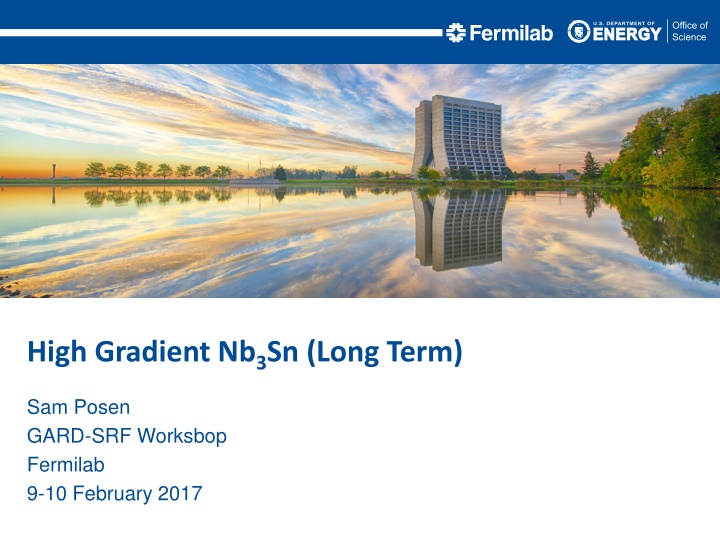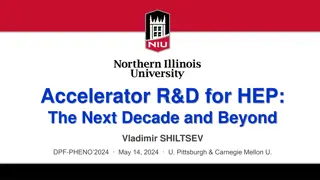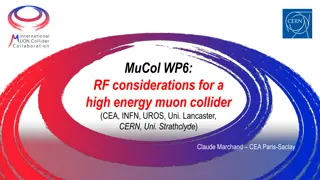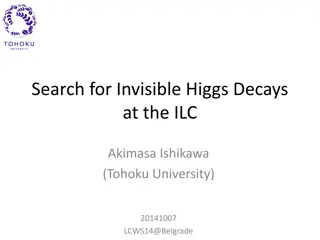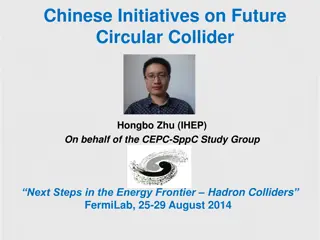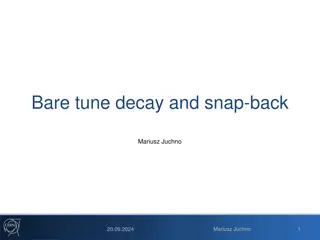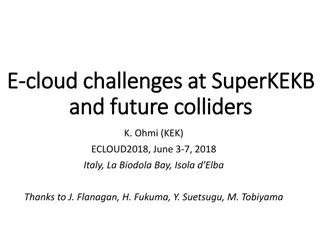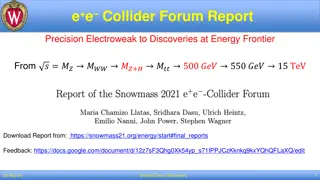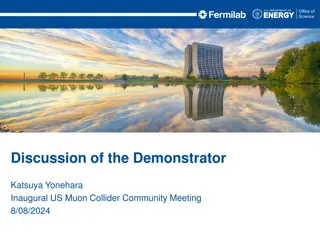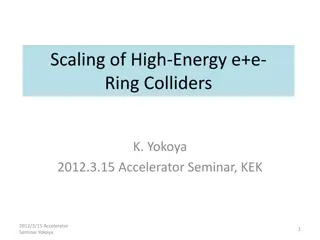Advancements in High-Energy Collider Technology
The content discusses the development of Nb3Sn coatings to withstand high magnetic fields, potential cost reductions, and the importance of maintaining high Q0 to sustain maximum fields. Additionally, it highlights the advantages of using 4.2 K technology in cryogenic plants for increased efficiency and reduced infrastructure costs. The analysis by Tom Peterson on cost reduction for 4.5 K ILC showcases significant savings by eliminating 2.0 K features.
Download Presentation

Please find below an Image/Link to download the presentation.
The content on the website is provided AS IS for your information and personal use only. It may not be sold, licensed, or shared on other websites without obtaining consent from the author.If you encounter any issues during the download, it is possible that the publisher has removed the file from their server.
You are allowed to download the files provided on this website for personal or commercial use, subject to the condition that they are used lawfully. All files are the property of their respective owners.
The content on the website is provided AS IS for your information and personal use only. It may not be sold, licensed, or shared on other websites without obtaining consent from the author.
E N D
Presentation Transcript
High Gradient Nb3Sn (Long Term) Sam Posen GARD-SRF Worksbop Fermilab 9-10 February 2017
High Energy Collider with Gradients >50 MV/m? If Nb3Sn was developed to withstand fields up to Hsh~0.4 T (transformative), this would correspond to over 80 MV/m Predicted cost reduction ~30% possible, but requires high Q0 to maintained out to maximum fields Will be important to keep Rressmall RBCSnegligible for Nb3Sn at 2 K Gradient? MV/m? Gradient? MV/m? 80? ILC? SRF? Linac? Cost? vs.? Gradient? and? Q0? 60? 70? 80? 50? 70? 40? 60? 30? 50? 20? 40? 30? 20? 60? 60? 140? Q=4.0E+09? Linac? Cost? (%? of? nominal)? Linac? Cost? (%? of? nominal)? 70? 70? 130? Q=6.0E+09? Linac? Cost? (%? of? nominal)? 80? 80? Q=8.0E+09? 120? Q=1.6E+10? 90? 90? 110? Q=3.2E+10? 100? 100? 100? Q=3.2E+10? Q=3.2E+10? 110? 110? 90? Q=1.6E+10? Q=1.6E+10? 120? 120? Q=8.0E+09? Q=8.0E+09? 80? Q=6.0E+09? Q=6.0E+09? 130? 130? 70? Q=4.0E+09? Q=4.0E+09? 140? 140? 60? ILC? SRF? Linac? Cost? vs.? Gradient? and? Q0? ILC? SRF? Linac? Cost? vs.? Gradient? and? Q0? 20? 30? 40? 50? 60? 70? 80? Gradient? MV/m? 2 9/23/2024 Sam Posen
High Energy Collider with Gradients >50 MV/m? If Nb3Sn coatings were developed to withstand fields up to Hsh~0.4 T, this would correspond to over 80 MV/m Predicted cost reduction ~30% possible, but requires high Q0 to maintained out to maximum fields Will be important to keep Rres small RBCS negligible for Nb3Sn at 2 K ILC? SRF? Linac? Cost? vs.? Gradient? and? Q0? 140? Q=4.0E+09? 130? Q=6.0E+09? Linac? Cost? (%? of? nominal)? Q=8.0E+09? 120? Q=1.6E+10? 110? Q=3.2E+10? 100? 90? 80? 70? 60? 20? 30? 40? 50? 60? 70? 80? Gradient? MV/m? 3 9/23/2024 Sam Posen
4.2 K ILC? Other advantages (Tom Peterson): Increased reliability of the cryogenic plant, since cold compressors are not used Reduced risk of air leaks causing contamination of the helium (no subatmospheric volumes) Relatively easy and fast capacity adjustment to load changes; good turn-down capability Less expensive infrastructure (no 2 K cold box, no cold compressors) No superfluid leaks Primary advantage: 3-4x higher efficiency Smaller infrastructure costs and reduced power consumption 1500 1000 PAC/Pdiss 500 0 1 2 3 4 5 T [K] 4 9/23/2024 Sam Posen
Calculation of Cost Reduction for 4.5 K ILC Based on analysis by Tom Peterson Assumptions: 1. Same ILC spacing, distances, and layout 2. No changes in heat load estimates other than the one small change eliminating 2.0 K support post heat 3. Remove all 2.0 K features including the 2.0 K cold box - 33% of original cryoplant cost (agrees with LHC design report) 4. Required capacity for each cryogenic unit is calculated assuming 4.2 K operation and given Eacc and Q0 5. Scale the cost of that 4.5 K cryogenic system by heat load to the 0.6th power 5 9/23/2024 Sam Posen
4.5 K ILC? ILC? SRF? Linac? cost? vs.? Gradient? and? Q0? ILC? SRF? Linac? Cost? vs.? Gradient? and? Q0? 140? 140? Q=4.0E+09? Q=4.0E+09? 130? 130? Q=6.0E+09? Q=6.0E+09? Linac? Cost? (%? of? nominal)? Linac? Cost? (%? of? nominal)? Q=8.0E+09? 120? Q=8.0E+09? 120? Q=1.6E+10? Q=1.6E+10? 110? 110? Q=3.2E+10? Q=3.2E+10? 100? 100? 90? 90? 80? 80? 70? 70? 60? 60? 20? 30? 40? 50? 60? 70? 80? 20? 30? 40? 50? 60? 70? 80? Gradient? MV/m? Gradient? MV/m? 2.0 K 4.5 K 4.5 K system helps reduce cryogenic costs (analysis by Tom Peterson). Analysis is specific to ILC, but representative of significant cost savings for machines large and small that would benefit from high gradients. Need to understand impact to thermal stability at 4.5 K 6 9/23/2024 Sam Posen
